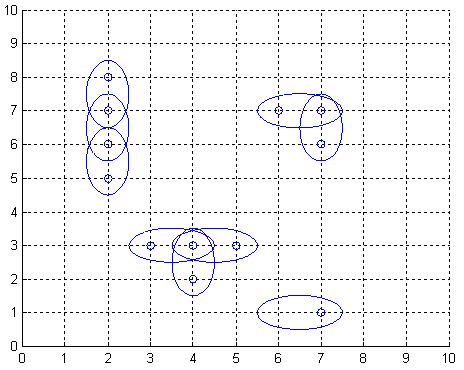Antenna Placement
| Time Limit: 1000MS | Memory Limit: 65536K | |
| Total Submissions: 12104 | Accepted: 5954 |
Description
The Global Aerial Research Centre has been allotted the task of building the fifth generation of mobile phone nets in Sweden. The most striking reason why they got the job, is their discovery of a new, highly noise resistant, antenna. It is called 4DAir, and comes in four types. Each type can only transmit and receive signals in a direction aligned with a (slightly skewed) latitudinal and longitudinal grid, because of the interacting electromagnetic field of the earth. The four types correspond to antennas operating in the directions north, west, south, and east, respectively. Below is an example picture of places of interest, depicted by twelve small rings, and nine 4DAir antennas depicted by ellipses covering them.

Obviously, it is desirable to use as few antennas as possible, but still provide coverage for each place of interest. We model the problem as follows: Let A be a rectangular matrix describing the surface of Sweden, where an entry of A either is a point of interest, which must be covered by at least one antenna, or empty space. Antennas can only be positioned at an entry in A. When an antenna is placed at row r and column c, this entry is considered covered, but also one of the neighbouring entries (c+1,r),(c,r+1),(c-1,r), or (c,r-1), is covered depending on the type chosen for this particular antenna. What is the least number of antennas for which there exists a placement in A such that all points of interest are covered?

Obviously, it is desirable to use as few antennas as possible, but still provide coverage for each place of interest. We model the problem as follows: Let A be a rectangular matrix describing the surface of Sweden, where an entry of A either is a point of interest, which must be covered by at least one antenna, or empty space. Antennas can only be positioned at an entry in A. When an antenna is placed at row r and column c, this entry is considered covered, but also one of the neighbouring entries (c+1,r),(c,r+1),(c-1,r), or (c,r-1), is covered depending on the type chosen for this particular antenna. What is the least number of antennas for which there exists a placement in A such that all points of interest are covered?
Input
On the first row of input is a single positive integer n, specifying the number of scenarios that follow. Each scenario begins with a row containing two positive integers h and w, with 1 <= h <= 40 and 0 < w <= 10. Thereafter is a matrix presented, describing the points of interest in Sweden in the form of h lines, each containing w characters from the set ['*','o']. A '*'-character symbolises a point of interest, whereas a 'o'-character represents open space.
Output
For each scenario, output the minimum number of antennas necessary to cover all '*'-entries in the scenario's matrix, on a row of its own.
Sample Input
2 7 9 ooo**oooo **oo*ooo* o*oo**o** ooooooooo *******oo o*o*oo*oo *******oo 10 1 * * * o * * * * * *
Sample Output
17 5
Source
1 // 题意:给一张图,图中有两种点,一次只能覆盖相邻(上下左右)两点 2 // 求最小覆盖数 3 // 二分图最小覆盖数等于最大匹配数,匈牙利算法求最大匹配数 4 // 此题建图方面有些繁琐,看了大佬的题解后,才建图成功 5 6 7 #include <cstdio> 8 #include <cstring> 9 10 using namespace std; 11 12 const int max_h = 44; 13 const int max_w = 14; 14 15 int h,w; 16 char s[max_h][max_w]; 17 18 int n; 19 int total=0,save=0,cur; 20 int direct[4][2]={{1,0},{-1,0},{0,1},{0,-1}}; 21 22 const int max_n=500+5; 23 int cx[max_n],cy[max_n],st[max_n]; 24 bool vis[max_n]; 25 26 struct node 27 { 28 int y,nxt; 29 }; 30 // 这里数组开的小了点,但是刚好够用了,大佬在题解中开了比这大百倍的数组。不知道为什么 31 // 这个数组的最大用量,应该由add函数的使用上限决定 32 // 每遍历一个点,最多在上下左右四个方向进行一次add函数的调用,所以只需要4*max_n次即可 33 node way[2000]; 34 35 // 计算在一维数组中的位置 36 int get(int i,int j) 37 { 38 return i*w+j; 39 } 40 41 void add(int u,int v) 42 { 43 ++cur; 44 // 当前数组中存储邻接点v和st【u】 45 way[cur].y=v; 46 way[cur].nxt=st[u]; 47 // st数组存储当u的边在数组中的位置 48 st[u]=cur; 49 } 50 51 int match(int x) 52 { 53 for(int i=st[x];i;i=way[i].nxt) 54 { 55 int y=way[i].y; 56 if(!vis[y]) 57 { 58 vis[y]=1; 59 if(!cy[y] || match(cy[y])) 60 { 61 cx[x]=y; 62 cy[y]=x; 63 return 1; 64 } 65 } 66 } 67 return 0; 68 } 69 70 int XYL() 71 { 72 memset(cx,0,sizeof(cx)); 73 memset(cy,0,sizeof(cy)); 74 int ans=0; 75 for(int i=0;i<n;++i) 76 { 77 // 遍历所有节点,如果找到没有匹配的x,看能否找到与之匹配的y 78 // 这里加了一步判断,对st[i]不为0的判断,也就是对当前节点不为'o'的判断 79 // 不加这一个判断也可得出正确的结果,但加入后会有优化,不用再执行之后许多无用的操作 80 // 毕竟只有'*'的点需要匹配不是吗? 81 if(!cx[i] && st[i]) 82 { 83 memset(vis,0,sizeof(vis)); 84 ans+=match(i); 85 } 86 } 87 return ans; 88 } 89 90 int main() 91 { 92 int T; 93 scanf("%d",&T); 94 while(T--) 95 { 96 // 输入数据 97 scanf("%d %d",&h,&w); 98 for(int i=0;i<h;++i) 99 { 100 scanf("%s",s[i]); 101 } 102 103 // 初始化way数组和st数组 104 cur=0; 105 memset(st,0,sizeof(st)); 106 // n表示总节点数 107 n=h*w; 108 // total表示*的总数 109 total=0; 110 111 112 for(int i=0;i<h;++i) 113 { 114 for(int j=0;j<w;++j) 115 { 116 if(s[i][j]=='*') 117 { 118 ++ total; 119 // 检查相邻四个方向 120 for(int k=0;k<4;++k) 121 { 122 int tx=i+direct[k][0]; 123 int ty=j+direct[k][1]; 124 // 在图的范围内且为*时,加边 125 if(tx>=0 && tx<h && ty>=0 && ty<w) 126 { 127 if(s[tx][ty]=='*') 128 { 129 int u=get(i,j); 130 int v=get(tx,ty); 131 add(u,v); 132 // printf("add"); 133 } 134 } 135 } 136 } 137 } 138 } 139 140 //printf("cur:%d ",tot); 141 142 printf("%d ",total-XYL()/2); 143 } 144 return 0; 145 } 146 147 /* 148 2 149 7 9 150 ooo**oooo 151 **oo*ooo* 152 o*oo**o** 153 ooooooooo 154 *******oo 155 o*o*oo*oo 156 *******oo 157 10 1 158 * 159 * 160 * 161 o 162 * 163 * 164 * 165 * 166 * 167 * 168 */